- Home
- About
- Map
- Trips
- Bringing Boat West
- Migration West
- Solo Motorcycle Ride
- Final Family XC Trip
- Colorado Rockies
- Graduates' XC Trip
- Yosemite & Nevada
- Colorado & Utah
- Best of Utah
- Southern Loop
- Pacific Northwest
- Northern Loop
- Los Angeles to NYC
- East Coast Trips
- 1 Week in Quebec
- Southeast Coast
- NH Backpacking
- Martha's Vineyard
- Canadian Maritimes
- Ocracoke Island
- Edisto Island
- First Landing '02
- Hunting Island '02
- Stowe in Winter
- Hunting Island '01
- Lake Placid
- Chesapeake
- Provincetown
- Hunting Island '00
- Acadia in Winter
- Boston Suburbs
- Niagara Falls
- First Landing '99
- Cape Hatteras
- West Coast Trips
- Maui
- Mojave 4WD Course
- Colorado River Rafting
- Bishop & Death Valley
- Kauai
- Yosemite Fall
- Utah Off-Road
- Lost Coast
- Yosemite Valley
- Arizona and New Mexico
- Pescadero & Capitola
- Bishop & Death Valley
- San Diego, Anza Borrego, Joshua Tree
- Carmel
- Death Valley in Fall
- Yosemite in the Fall
- Pacific Northwest
- Utah Off-Roading
- Southern CA Deserts
- Yosemite & Covid
- Lake Powell Covid
- Eastern Sierra & Covid
- Bishop & Death Valley
- Central & SE Oregon
- Mojave Road
- Eastern Sierra
- Trinity Alps
- Tuolumne Meadows
- Lake Powell Boating
- Eastern Sierra
- Yosemite Winter
- Hawaii
- 4WD Eastern Sierra
- 4WD Death Valley +
- Southern CA Deserts
- Christmas in Tahoe
- Yosemite & Pinnacles
- Totality
- Yosemite & Sierra
- Yosemite Christmas
- Yosemite, San Diego
- Yosemite & North CA
- Seattle to Sierra
- Southwest Deserts
- Yosemite & Sierra
- Pacific Northwest
- Yosemite & South CA
- Pacific Northwest
- Northern California
- Southern Alaska
- Vancouver Island
- International Trips
- Index
- Tips
- Books
- Photos/Videos
- Search
- Contact
Bangkok, Thailand
Thursday, March 15, 2018 - 8:00am by Lolo
0 miles and 0 hours from our last stop - 3 night stay
Travelogue
Day 1 (or possibly Day 3, depending on how you think about it)
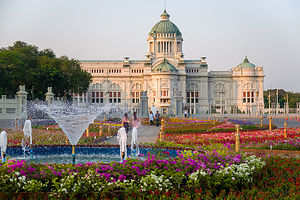 Dusit PalaceWe left our house for the airport on a Tuesday night and arrived in Bangkok on Thursday morning. Where did Wednesday go? Perhaps we would find it on the way back home.
Dusit PalaceWe left our house for the airport on a Tuesday night and arrived in Bangkok on Thursday morning. Where did Wednesday go? Perhaps we would find it on the way back home.
Thankfully, a smiling Gate1-arranged driver was there to greet us at the airport and deliver us to the Century Park Hotel where we would be spending the first 3 nights of our trip. Once deposited inside the lobby, we were relieved of our luggage, handed a refreshing drink, and approached by another smiling man, which turned out to be Mr. Udom, our Gate1 tour guide for the next 12 days.
What we were quickly learning about the culture of Thailand is that everyone smiles, and it is truly genuine. They have to be one of the friendliest and most hospitable people in the world.
The hotel was lovely and far more luxurious than what I am used to - after all, our primary means of travel is a motorhome. I could definitely get used to this.
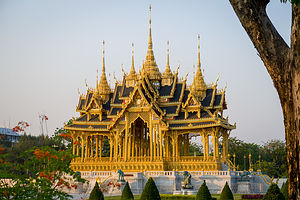 Temple on the Dusit Palace groundsThe actual guided part of our tour didn’t start until the next morning, so we had the rest of the day to ourselves. After a quick nap, we decided to set out on foot to do a bit of an exploratory. With the humidity and action-packed days on the tour ahead of us, we knew our only form of exercise would be walking, so we planned to do as much of it as possible.
Temple on the Dusit Palace groundsThe actual guided part of our tour didn’t start until the next morning, so we had the rest of the day to ourselves. After a quick nap, we decided to set out on foot to do a bit of an exploratory. With the humidity and action-packed days on the tour ahead of us, we knew our only form of exercise would be walking, so we planned to do as much of it as possible.
The second thing we learned about Thailand is that it is not particularly pedestrian-friendly and that you take your life in your hands every time you step off a curb. Speeding, aggressive lane changing, crazy tuk tuk drivers, motorbikes with entire helmet-less families on them is the norm. Also, they drive on the other side of the street, so we found ourselves looking the wrong direction for oncoming vehicles. The incredible thing is that there is no horn honking. I’m not sure if it’s because nothing could possibly surprise anyone in this chaos or that the Thai people are too polite to honk.
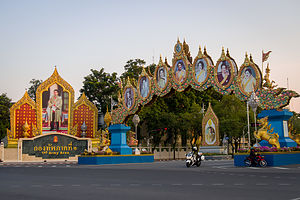 Portraits of the royal familyNot exactly knowing what we were doing, we looked on the map for an interesting destination within walking distance from our hotel and came up with the Dusit Royal District, a park-like setting with royal palaces, temples, and administrative buildings, about 3 ½ miles away.
Portraits of the royal familyNot exactly knowing what we were doing, we looked on the map for an interesting destination within walking distance from our hotel and came up with the Dusit Royal District, a park-like setting with royal palaces, temples, and administrative buildings, about 3 ½ miles away.
The Dusit district is Bangkok's "new" royal city. It was established by King Rama V in the early 20th century upon his return from a European tour, where he was exposed to the great capitals of the west. Inspired by what he saw and wanting to appear modern, Rama V established a new palace compound which he named Dusit, which means "Heavenly Garden."
Unfortunately for us, the grounds were closed by the time we arrived, so we had to peer through the iron fences to take photos, always under the watchful eyes of the palace guards, standing at attention at each entrance to the grounds. I got the feeling they were not going to make an exception and let us take a closer peek.
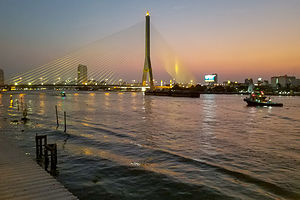 View of Chao Phraya River from In Love outdoor patioWithin the fenced and highly guarded compound was a huge ornate Italianate building called the Ananta Samakorn Throne Hall. Closed to the public, except for one day a year, this building housed the Thai parliament before the 1932 coup which ended the absolute monarchy. The history of Thailand’s kings and government gets pretty confusing, so I am not going to even attempt to get into it in any depth, except to give places we visited some context. Today, this beautiful building is used for state occasions.
View of Chao Phraya River from In Love outdoor patioWithin the fenced and highly guarded compound was a huge ornate Italianate building called the Ananta Samakorn Throne Hall. Closed to the public, except for one day a year, this building housed the Thai parliament before the 1932 coup which ended the absolute monarchy. The history of Thailand’s kings and government gets pretty confusing, so I am not going to even attempt to get into it in any depth, except to give places we visited some context. Today, this beautiful building is used for state occasions.
The plaza in front of the throne hall, which we could walk through, had a beautiful garden and fountain and a large equestrian statue of King Rama V. Surrounding the plaza are large, ornately framed portraits of the royal family. That’s another thing we would quickly learn about Thailand - the importance of the royal family to them. There are photos of the king (present one and the one that recently passed away) everywhere in Thailand. King Rama IX, who passed away in 2016 after ruling the Thai people for 70 years, is particularly beloved and looked upon as a father to the people. I think they are still feeling out the new king, Rama X. He has some pretty big shoes to fill.
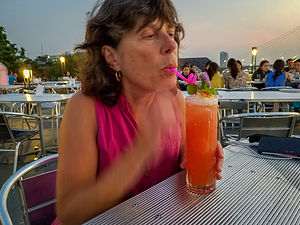 Lolo enjoying her first Mai Tai in ThailandFrom the royal district, we walked another mile to a restaurant called In Love, overlooking the Chao Phraya River, with great views of the Rama VIII Bridge. We sat out on the patio, which I have to say was pretty magical, made even more so by a refreshing Mai Tai.
Lolo enjoying her first Mai Tai in ThailandFrom the royal district, we walked another mile to a restaurant called In Love, overlooking the Chao Phraya River, with great views of the Rama VIII Bridge. We sat out on the patio, which I have to say was pretty magical, made even more so by a refreshing Mai Tai.
I did panic a bit half way through the drink when I remembered that we were warned not to drink tap water or ice cubes made from tap water. This was a pretty upscale restaurant frequented by tourists unarmed with bad-water fighting bacteria, so I tried to reassure myself that the ice cube that I was swirling around in my mouth was just fine. I forged on.
Dinner was delightful. The food was fine, but the view was what really made it. What a nice way to end our first day in Bangkok.
Actually, it wasn’t quite over yet. We had walked five miles from our hotel to get here, and we had no intention of walking back. There weren’t a whole lot of cabs near the restaurant, so we continued walking another mile and a half to Khao San Road, where there is a lot of night action and hopefully a means of transport home.
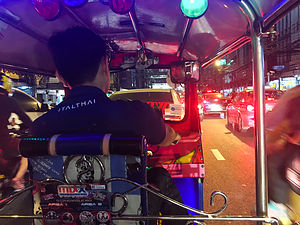 View out of our tuk tukOnce a major rice market, today Khao San Road has become a world-famous “backpacker ghetto”, with cheap accommodations, internet cafes, massage parlors, tattoo shops, and countless bars and restaurants. It was quite the happening scene, with loud music emanating from bars and tons of food stalls hawking such delicacies as barbecued insects and other exotic snacks.
View out of our tuk tukOnce a major rice market, today Khao San Road has become a world-famous “backpacker ghetto”, with cheap accommodations, internet cafes, massage parlors, tattoo shops, and countless bars and restaurants. It was quite the happening scene, with loud music emanating from bars and tons of food stalls hawking such delicacies as barbecued insects and other exotic snacks.
As suspected there were plenty of cabs and tuk tuks. While Herb was haggling with a cab driver, I pointed to a tuk tuk and asked how much. “Same price as taxi,” he said. For those that don’t know what a tuk tuk is - which was me about a week ago - it’s a three-wheeled motor vehicle driven by a crazy person (just kidding).
There was still one more adventure before calling it a day - a wild, extremely exhilarating tuk tuk ride back to our hotel. Our neighbor, who has traveled the world and been to Thailand on numerous occasions, told us that we just had to experience a tuk tuk ride, even if just once. Well, she was right. It was probably the wildest and most exhilarating experience I have had in a long time. We made it back to our hotel in record time, but I do think “just once” is sound advice.
Day 2 - The Official Tour Begins: Wat Pho and the famous Reclining Buddha
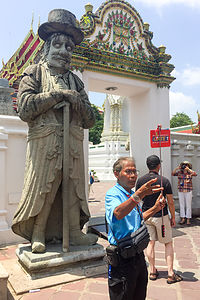 Udom leading the wayThis was the first day of our guided tour. For the next 10 days, we would entrust ourselves to Mr. Udom to learn about and absorb the fascinating culture of Thailand, and hopefully experience some great Thai food along the way.
Udom leading the wayThis was the first day of our guided tour. For the next 10 days, we would entrust ourselves to Mr. Udom to learn about and absorb the fascinating culture of Thailand, and hopefully experience some great Thai food along the way.
The bright red Gate1 tour bus (easy to find) was quite impressive - clean, comfortable reclining seats, and surprisingly only half full, as our fellow travelers only numbered 23, while the bus could easily hold twice that number. We didn’t know anybody yet, so it felt a little like the first day of school, where we nervously looked around hoping to make new friends.
Everyone seemed nice and friendly, and there was a wider range in ages than I expected - most in their late 40s to early 60s, but also 3 in their 20s and one very robust octogenarian.
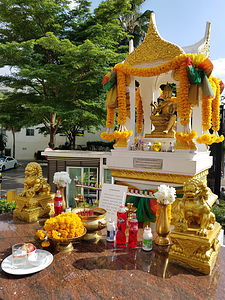 Spirit HouseMr. Udom (who we later just called Udom) had a microphone and he knew how to use it - in a really good way. For the entire 10 day tour, he never just sat back and enjoyed the ride, but continually, and quite enthusiastically, shared his vast knowledge about the country he obviously loved so dearly.
Spirit HouseMr. Udom (who we later just called Udom) had a microphone and he knew how to use it - in a really good way. For the entire 10 day tour, he never just sat back and enjoyed the ride, but continually, and quite enthusiastically, shared his vast knowledge about the country he obviously loved so dearly.
As we drove through the streets of Bangkok towards Chinatown and the Indian Market, Udom gave us some basic information about the culture - the Buddhist religion (to which he very devoutly belonged), the political structure and the Thai people’s relationship to their king, the progress Thailand was making to become a modern day country, etc.
Before we knew it, we were getting off the bus at a market along the river, following Udom and his Gate1 flag. Rather than a totally structured tour and spiel, Udom would just stop and talk about interesting things we passed along the way. He stopped at a food vendor to buy us fresh mangos and then again in front of a beautiful dollhouse-sized home atop a pedestal - which I had been curious about because they seemed to be all over - even in front of our high-rise hotel.
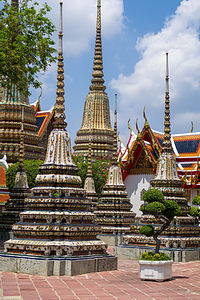 Wat Pho chedis (or stupas) used to house the remains of Buddhist monks or nunsAs Udom explained, these were “spirit houses” often placed in the corner of a property to provide shelter for spirits that might otherwise cause trouble - usually those that once owned and lived on this property. Offerings, such as votive candles, flowers, and fruit are often left at the house to propitiate the spirits. Although 95% of the Thai population is Buddhist, spirit house rituals are based on ancient animistic practices inherited from their ancestors thousands of years ago.
Wat Pho chedis (or stupas) used to house the remains of Buddhist monks or nunsAs Udom explained, these were “spirit houses” often placed in the corner of a property to provide shelter for spirits that might otherwise cause trouble - usually those that once owned and lived on this property. Offerings, such as votive candles, flowers, and fruit are often left at the house to propitiate the spirits. Although 95% of the Thai population is Buddhist, spirit house rituals are based on ancient animistic practices inherited from their ancestors thousands of years ago.
Next, Udom let us loose in a huge warehouse building which held the Pak Klong Talad Flower Market, the largest flower market in Bangkok, with instructions to meet him at the other end in 20 minutes. I have never seen so many flowers for sale in one place. The varieties sold ranged from local species (jasmine, chrysanthemum, orchids, lilies, roses, etc.) to imported species such as tulips, snapdragons, iris, delphinium, and more - and very inexpensive.
I think I mentioned in yesterday’s write-up that the streets of Bangkok are not particularly pedestrian friendly, but we were still taken aback when we had to move out of the way of motorcycles riding up the aisles of the flower market. We were going to have to keep our wits about us.
Then it was back on the bus and on to our major attraction for the day - Wat Pho, the largest of Bangkok’s Buddhist temples and home to the famous 150-foot Reclining Buddha. Although many use the word temple and wat interchangeably, Udom explained to us that a temple is not officially a wat unless it has an ordination hall.
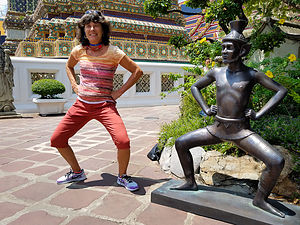 Lolo doing some bad yogaUpon entering the courtyard, we were greeted by a group of beautiful Chinese conical structures, decorated in ceramic pottery flowers and colorful tiles. They are called chedis (or stupas), and they house relics, generally the remains of Buddhist monks or nuns.
Lolo doing some bad yogaUpon entering the courtyard, we were greeted by a group of beautiful Chinese conical structures, decorated in ceramic pottery flowers and colorful tiles. They are called chedis (or stupas), and they house relics, generally the remains of Buddhist monks or nuns.
Behind the chedis are a series of multi-peaked, steeply roofed buildings - also glittery with lots of shimmering gold plate. Each of the roof peaks was adorned with a blade-like projection, called a chofah, that resembled a tall thin bird, and is believed to represent Garuda, a legendary bird in Buddhist and Hindu mythology.
Please forgive my rather awkward attempt at describing Thailand architecture and refer to our photos instead to truly appreciate the beauty of this place.
Continuing on to the main temple, we passed through a lovely garden populated by whimsical bronze statues (with elf-like ears) in various yoga poses. Needless to say, we couldn’t resist imitating them for a photo or two.
Our next stop, and the Wat Pho’s main attraction was the temple of the Reclining Buddha. As with any Buddhist temple, we had to leave our shoes outside and make sure that our clothing covered our shoulders and knees. We entered at the temple at the head of the Buddha and strolled along its 150 foot gold-plated body to its giant 16-foot feet. The bottom of the toes are decorated in mother-of-pearl swirling spires - 3 on each toe. This particular Buddha sculpture is not detailed in its rendering of the human body, but it more than makes up for it in its enormity.
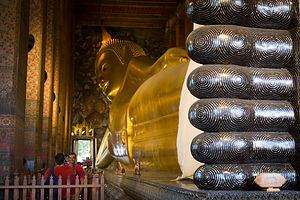 Reclining Buddha's tootsiesAfter rounding the Buddha’s feet, we strolled back along the other side of his body. The wall on this side contained a long table with 108 bronze bowls, used to collect donations to help preserve Wat Pho. 108 is a sacred number in Buddhism. It refers to the 108 positive actions and symbols that helped lead Buddha to perfection, and it is also the number of beads on a Buddhist prayer bead. Conveniently located at the start of the table was a woman selling a handful of coins (108 of them in fact). Striving for perfection and not looking like cheap tourists, we purchased our coins and dropped them one by one in the series of bowls. It actually was quite a mindful exercise, as we tried to focus on the dropping of each coin into the bowl. Actually Herb did. I was too busy trying to pass the slower people in front of me.
Reclining Buddha's tootsiesAfter rounding the Buddha’s feet, we strolled back along the other side of his body. The wall on this side contained a long table with 108 bronze bowls, used to collect donations to help preserve Wat Pho. 108 is a sacred number in Buddhism. It refers to the 108 positive actions and symbols that helped lead Buddha to perfection, and it is also the number of beads on a Buddhist prayer bead. Conveniently located at the start of the table was a woman selling a handful of coins (108 of them in fact). Striving for perfection and not looking like cheap tourists, we purchased our coins and dropped them one by one in the series of bowls. It actually was quite a mindful exercise, as we tried to focus on the dropping of each coin into the bowl. Actually Herb did. I was too busy trying to pass the slower people in front of me.
Out final stop in Wat Pho was the ordination hall, which if you recall, made this complex of temples and chedis an official “Wat.” An ordination hall is used for performance of the ordination of Buddhist monks and other ritual ceremonies.
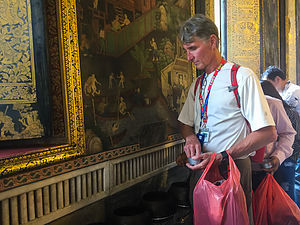 Herb giving alms at Wat PhoThe hallway we first entered contained a series of about a dozen gold-plated buddhas sitting in the lotus position. From there we entered the ubosot where the actual ordinations of new monks take place. Inside the ubosot there was a magnificent alter with a large Buddha, finished in gold and crystal with a large gold cone hanging above its head. Visitors are welcome to respectfully kneel in devotion or prayer before the altar. You don’t have to be a Buddhist to benefit from a moment of contemplation in this serene and spiritual setting.
Herb giving alms at Wat PhoThe hallway we first entered contained a series of about a dozen gold-plated buddhas sitting in the lotus position. From there we entered the ubosot where the actual ordinations of new monks take place. Inside the ubosot there was a magnificent alter with a large Buddha, finished in gold and crystal with a large gold cone hanging above its head. Visitors are welcome to respectfully kneel in devotion or prayer before the altar. You don’t have to be a Buddhist to benefit from a moment of contemplation in this serene and spiritual setting.
It seemed like we had seen far too much of Bangkok already for it to only be 1:30 in the afternoon, but that is what it was when the Gate1 bus brought us back to the Century Park Hotel. We were on our own for lunch, so we consulted our Gate1 packet for recommendations on restaurants near the hotel. We selected Baan Ajarn, a cozy restaurant and pub, just a short walk from our hotel. Herb is allergic to shellfish so he was warned to be very careful ordering as even curries sometimes have oyster sauce. We decided to play it safe and order the chicken with cashews. It was delicious, and as we would continue to find out, very reasonable.
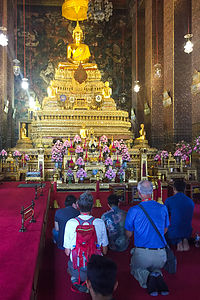 Herb in Wat Pho templeThe only other thing on the agenda for the day was a Gate1 welcome reception, hosted by Mr. Udom, in the hotel bar at 6:00 (one free drink included). Plenty of time for a quick nap before. Although we were ready in plenty of time, Herb suggested we arrive about 10 minutes fashionably late. I argued that since we did not know the custom in Thailand regarding punctuality, we should be there by 6:00. I really tried hard not to say “I told you so,” when Mr. Udom called our room phone at 6:03 asking us if we were coming down.
Herb in Wat Pho templeThe only other thing on the agenda for the day was a Gate1 welcome reception, hosted by Mr. Udom, in the hotel bar at 6:00 (one free drink included). Plenty of time for a quick nap before. Although we were ready in plenty of time, Herb suggested we arrive about 10 minutes fashionably late. I argued that since we did not know the custom in Thailand regarding punctuality, we should be there by 6:00. I really tried hard not to say “I told you so,” when Mr. Udom called our room phone at 6:03 asking us if we were coming down.
So, we apologetically slinked into the bar where everyone was seated on couches and chairs waiting for us. I don’t think we made a particularly good first impression.
We spent a pleasant hour introducing ourselves to each other and listening Udom explain what we could expect over the next 10 days. Herb and I were the only Group Tour virgins in the room. Literally everyone else had been on at least a few Gate1 tours before. Everyone seemed really friendly and interesting, and raved about their previous Gate1 experiences. Okay, maybe this group thing wasn’t going to be too bad.
From the bar, we transitioned to the hotel dining room, where there was a buffet with enough food to feed an army. This was the first of many hotel buffets we would dine at this trip, and it was wonderful. Not being a connoisseur of Thai cuisine, it gave me a wonderful opportunity to sample a wide variety of Thai food options.
Satiated, Happy, and Exhausted, we headed up to our room with instructions to meet in the lobby 8:30 the next morning.
Day 3 - Grand Palace / Wat Phra Kaew (Temple of the Emerald Buddha) and Siam Niramit Show & Dinner
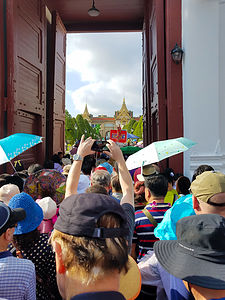 Swimming upstream into the Grand PalaceWe started our day with a wonderfully delicious and copious breakfast at the hotel buffet. If this kept up, we would be returning home with about 10 extra pounds.
Swimming upstream into the Grand PalaceWe started our day with a wonderfully delicious and copious breakfast at the hotel buffet. If this kept up, we would be returning home with about 10 extra pounds.
Then it was onto Bangkok’s most visited attraction - the Grand Palace, which served as the official residence of the Kings of Siam (and later Thailand), as well as the administrative and religious center of the kingdom from 1782, when King Rama I moved the capital city from Thonburi to Bangkok, until the abolition of absolute monarchy in 1932. Today, besides being a major tourist attraction, the Grand Palace still remains a working palace, with several royal offices still situated inside.
Upon disembarking from the bus, Udom herded us like cattle through the gates of the Grand Palace, while we desperately tried to keep our eye on the Gate1 flag faithfully waving above the endless sea of humanity. Fortunately, we all were wearing earphones through which we could hear Udom speaking into a microphone. To this day, I can still here, “Gate1, Gate1, this way Gate1.”
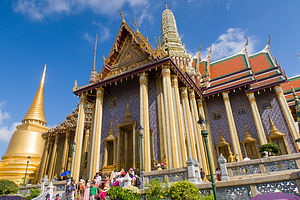 Wat Phra KaewRather than being a single structure, the Grand Palace is made up of numerous buildings, halls, temples, and gardens. There is not one unified architectural style in the complex, because each successive king made additions based on their preference. For example, in the 1860s when Anna Leonowens worked as governess during the reign of Rama IV (made famous in the movie the King of Siam), a bit of western influence begins to be seen.
Wat Phra KaewRather than being a single structure, the Grand Palace is made up of numerous buildings, halls, temples, and gardens. There is not one unified architectural style in the complex, because each successive king made additions based on their preference. For example, in the 1860s when Anna Leonowens worked as governess during the reign of Rama IV (made famous in the movie the King of Siam), a bit of western influence begins to be seen.
We began our tour of the palace complex in the temple compound generally referred to as Wat Phra Kaew. A covered walkway surrounded the area, the inner walls of which were covered with murals (178 panels in all), depicting the Hindu epic, the Ramayana, which describes Rama’s struggles to retrieve his kidnapped wife.
 Young Buddhist monks playing with their material possessionsOn the steps of the courtyard were about half a dozen teen-age monks (or monks in training) clad in traditional orange robes totally absorbed, not with contemplating their path to Nirvana, but rather with their cell phones. We found this an interesting juxtaposition to the ancient mythological portrayals behind them and asked Udom how cell phones fit in with the disposal of all earthly possessions.
Young Buddhist monks playing with their material possessionsOn the steps of the courtyard were about half a dozen teen-age monks (or monks in training) clad in traditional orange robes totally absorbed, not with contemplating their path to Nirvana, but rather with their cell phones. We found this an interesting juxtaposition to the ancient mythological portrayals behind them and asked Udom how cell phones fit in with the disposal of all earthly possessions.
In their defense, he explained that it is all about the motive for owning a possession and how it is used rather than the object itself. If used as a way of connecting with loved ones, then it is a good thing; playing video games, not so much so. He further explained that these boys were most likely short-term monks (novices) rather than those that dedicate their entire life to celibacy and a monastic life. In Thailand, most young men will enter the monkhood before marriage for about a three month period, generally from July to October - kind of like summer camp. Udom didn’t say that. That was my own interpretation.
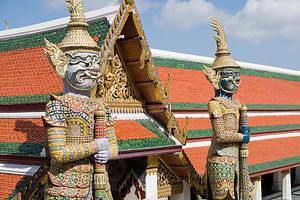 Yakshas guarding the temple gates at Wat Phra KaewFrom the courtyard, we passed through a gateway, guarded by some scary creatures called Yaksha, into the inner compound where the famous Temple of the Emerald Buddha resides. Unfortunately, you are not allowed to take photos of the Emerald Buddha, which is really a shame, because at our age if we don’t have a photo, it never happened.
Yakshas guarding the temple gates at Wat Phra KaewFrom the courtyard, we passed through a gateway, guarded by some scary creatures called Yaksha, into the inner compound where the famous Temple of the Emerald Buddha resides. Unfortunately, you are not allowed to take photos of the Emerald Buddha, which is really a shame, because at our age if we don’t have a photo, it never happened.
The most surprising thing to us was how small he is - just 26 inches tall. Despite his diminutive size, however, this Buddha is considered to be the most important icon for the Thai people, who feel that the safety of the nation is dependent upon it. Despite being referred to as the “Emerald” Buddha, it is not made from emerald, but rather jade.
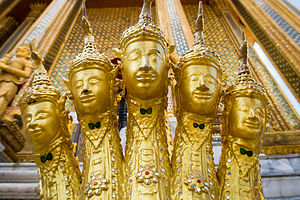 5-headed nagas of Wat Phra KaewRaised high on a series of ornately, jeweled platforms, no one but the king is allowed near the Buddha. The Buddha wears a golden seasonal cloak, changed three times a year to correspond to the summer, winter, and rainy season. A very important ritual called the changing of the robes is performed by the King to bring good fortune to the country during each season, typically in March, August, and November. On March 2nd of this year, the new Thai king, Rama X, changed the Emerald Buddha’s seasonal attire from winter to summer.
5-headed nagas of Wat Phra KaewRaised high on a series of ornately, jeweled platforms, no one but the king is allowed near the Buddha. The Buddha wears a golden seasonal cloak, changed three times a year to correspond to the summer, winter, and rainy season. A very important ritual called the changing of the robes is performed by the King to bring good fortune to the country during each season, typically in March, August, and November. On March 2nd of this year, the new Thai king, Rama X, changed the Emerald Buddha’s seasonal attire from winter to summer.
I’d like to digress a minute to talk a little more about the fascinating mythical creatures scattered throughout the complex, because they are what I will remember most from the Grand Palace, and even if I do forget, unlike the Emerald Buddha, I will have photos of them to jog my memory.
First, there are the yakshas, which we first encountered standing guard at the Temple of the Emerald Buddha. Yakshas are spiritual beings from Hindu literature that live in the subterranean earth and are the protectors of treasures. In Thailand, they have evolved to be guardians of gates, temples, and royal possessions. Their fierce, demon-likecreaturekii appearance certainly qualifies them for the task. These highly ornate, porcelain statues typically have bulging eyes, fangs, and multi-colored, monkey-liked faces and stand at attention, clutching a sword.
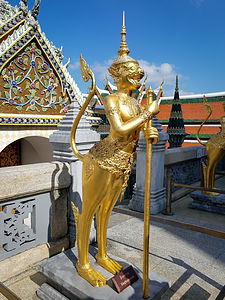 Kinaree at Wat Phra KaewThen there are the five-headed golden serpents called nagas. Their primary role is to protect the Buddha, so they are often positioned on stairs leading into a temple.
Kinaree at Wat Phra KaewThen there are the five-headed golden serpents called nagas. Their primary role is to protect the Buddha, so they are often positioned on stairs leading into a temple.
There are also several mixed creature statues, such as the golden statue with the legs and tail of a lion, the upper body of a woman, and the face of a monkey that is having a bad day. Very often these “kinaree” (mixed creature) statues have the upper body of a woman and the lower body of a bird. Their role is to watch over the well-being of humans in times of trouble or danger. I’m not so sure that the monkey-faced one had my best interests at heart.
My personal favorites, however, were the monkey statues (monkey faces with human bodies) that supported the Golden Chedi, in a traditional yoga pose. Their faces are similar to that of the yaksha and I suppose their appearance is ferocious enough to also make them effective guards, or perhaps fierce yoga instructors. Of course, we had to do the tourist thing and imitate them for a photo - silly, but necessary.
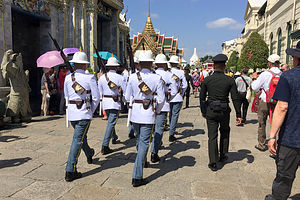 Changing of the Royal Guard at the Grand PalaceOne other note, mostly just to show off my new-found knowledge of Thai architecture, is the difference between the chedi here and at Wat Pho, which we visited yesterday. As you may or may not recall, chedi are structures used to hold relics, such as the remains of Buddhist monks or nuns. While Wat Pho’s chedis were conical and pointy and covered in colorful ceramic flowers and tiles, the chedis in the Grand Palace were golden and bell-shaped.
Changing of the Royal Guard at the Grand PalaceOne other note, mostly just to show off my new-found knowledge of Thai architecture, is the difference between the chedi here and at Wat Pho, which we visited yesterday. As you may or may not recall, chedi are structures used to hold relics, such as the remains of Buddhist monks or nuns. While Wat Pho’s chedis were conical and pointy and covered in colorful ceramic flowers and tiles, the chedis in the Grand Palace were golden and bell-shaped.
Like most royal complexes, the religious part (Wat Phra Kaew) is separated from the administrative offices and royal residences. Although most of the buildings in the Grand Palace section are not open to the public, we were still able to enjoy a brief tour of the exterior or the buildings, many of which were an interesting mix of Thai and western architectural styles.
Having completed our Grand Palace tour, our bus took us back to the hotel where we had a few hours of free time before the next event - the Siam Niramit Show & Dinner, which was an one of the optional activities that we added to our tour.
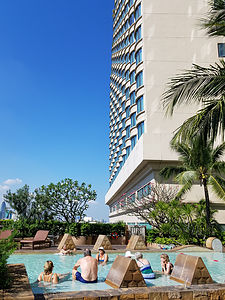 Century Park Hotel poolWe spent our precious free time in the Century Hotel Pool, where we ran into several of our fellow Gate1 travelers. The pool had a shallow section, obviously designed to provide a safe place to stay cool while sipping on one of the fancy drinks served a poolside waiter. I had my second Mai Tai of the trip (feeling confident that this hotel had good ice cubes), but Herb stuck with his go to while we were in Thailand, Chang Beer.
Century Park Hotel poolWe spent our precious free time in the Century Hotel Pool, where we ran into several of our fellow Gate1 travelers. The pool had a shallow section, obviously designed to provide a safe place to stay cool while sipping on one of the fancy drinks served a poolside waiter. I had my second Mai Tai of the trip (feeling confident that this hotel had good ice cubes), but Herb stuck with his go to while we were in Thailand, Chang Beer.
Refreshed, we were ready for the Siam Niramit Show. Our evening started with a buffet dinner, followed by a performance in the courtyard of dancers in traditional Thai clothing. There was also an elephant to ride, as well as two lovely, costumed Thai young ladies who you could pose with for 2 bhat. I encouraged a reluctant Herb to do it, because I thought the grin on his face, which I fully expected, would be worth it. I was right.
Just before 8:00, we were summoned to assume our seats in the theater, which were phenomenal. I’ve come to expect nothing less from Gate1. The stage is huge; in fact, according to the Guinness Book of World Records, it is the largest stage in the world. It was built to accommodate the show’s monumental set pieces, a legion of performers, including real elephants, and amazing special effects, including boats floating along a realistic river.
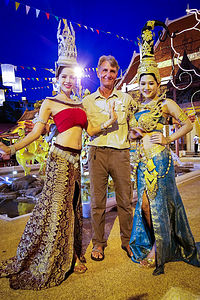 Peek inside Herb's fantasy worldThe show had the rather ambitious goal of portraying 700 years of Siam’s (now Thailand’s) history. The show is structured into three acts.
Peek inside Herb's fantasy worldThe show had the rather ambitious goal of portraying 700 years of Siam’s (now Thailand’s) history. The show is structured into three acts.
Act 1 portrays the cultural history and traditions of the Lanna Kingdom in the north, the role sea trade played in the south, as well as the formation of the Ayutthaya Kingdom in the 14th century.
Act 2 provides an understanding of the Law of Karma, in which Earthly deeds dictate what happens in our next lives. Remember, ninety percent of the population of Thailand are Theravada Buddhists and almost all of them believe in reincarnation, so this was not just fantasy for much of the audience, but rather a warning - kind of like the Last Judgment sculptural depictions over the portals of most Medieval cathedrals. The act begins with a Fiery Hell, where sinners are punished with tortures appropriate to their sins (a lot like Dante’s Inferno), followed by the Mystical Himmapan, a mystical forest which serves as the gateway between heaven and earth, and concluded with Blissful Heaven where angels dart across the stage casting pieces of twinkling tinsel. Happy Ending!
The final act portrays the joy and peace that Buddhism brings to its people as the stage explodes in a colorful celebration.
Wow! It was quite a show. Although it would have been a lot easier to follow along if we knew more about Thailand’s history, even without that the beautiful stage setting and costumes and the creative special effects kept us riveted every moment.
- 1 of 7
- next ›
Bangkok location map in "high definition"
Javascript is required to view this map.
